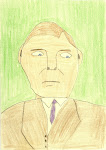A Photograph of Zachary Taylor.
“They're not as smart as Abraham Lincoln. They're not as courageous,” Simon declares. This week, reading about Franklin Pierce, he exclaims with genuine excitement: “Oh goody, Pierce is the fourteenth president. Only two to go until Lincoln. Lincoln will fix everything.”
Oh, goody. I'm delighted by Simon's excitement. I didn't know he had been keeping such careful count, or that he had fully comprehended how all pervasive the problem of slavery was, how it was the growling grizzly bear in the Oval Office and in Congress for every administration, somehow kept appeased by a diet of compromises.
But Simon does understand--the south insisted on slavery, the north wanted it abolished, yet year in, year out, decade in, decade out, the Union survived due to the imperfect but devoted work of this group of presidents.
Or, to be honest, that's what I understand. Simon gets that there was a BIG problem, that the BIG problem needed to be fixed, and that “forever” went by without it getting fixed.
Grown-ups value compromises. Eleven-year-old boys who have worked their way through stacks of superhero comics, as well as all things Greek, want someone to walk in with an army of 300 and fight to the death of all, if necessary, and change the course of history
* * *
The series of biographies Simon has been reading, Getting to Know the U.S. Presidents by Mike Venezia, is full of illustrations: painted portraits, etchings, maps, period prints and posters; however, beginning with these presidents, with only the exception of William Henry Harrison, the biographies invariably include a photographic portrait. How does my thoughtful, deep-feeling son respond to these black and white pictures, pictures that are not heroic portraits, pictures that show lined and wise faces in the flesh, in need of a haircut, and in rumpled clothes?
"Mom, he is so very ugly. He is so old. I don't like him. I don't like him at all. Actually, I think I hate him.”
Hate him? Really? When I pursue the question--“Why?”--I get an answer that reiterates what he has already said.
Somewhat irritated, and a little loud he says: “I told you already, Mom--are you deaf, or something?--because he's very old and ugly.”
I point out Zachary Taylor's military accomplishments, or Millard Fillmore's success in getting Japan to open up to trade.
"Yes, Mom, that's true. But they're old and ugly.”
So this is what I've been thinking about this week, working in my yard when I've had a minute--it's planting season in Miami. Why would Simon say that?
Yes, TV is to blame. From the cartoons he watches, he learns that surfaces seem to matter a lot.
And it is his age. Having recently become aware of just how young he is, he wants to have some power over the world, and naming its imperfections gives him a fleeting illusion of control. Again and again, he impulsively takes aggressive language out for a spin, sees what it feels like to flex your mots injuste muscles. So-and-so is old, or dumb, or mean, or fat, or ugly, or has bad judgment. Or worse. A moron. A turd.
And it is the kids his age he hangs with. They're all nice, yet every third word out of their mouths is an adjective describing something or someone with utter contempt: ugly, lame, boring, stupid.
It's a full-time job just to fight this verbal self-assertion, to talk about respect, generosity, kindness; to point out that no adult in our lives talks this way; to speak of the character of heroes—none of them called someone a moron; to remind him what it feels like to be on the receiving end of nastiness; to ask him what kind of world he wants to live in.
But I don't think that all the above adds up to an answer that explains why Simon responds so negatively to these presidents. I think the answer lies in the fact that of these presidents there are photographs.
Zachary Taylor, like William Henry Harrison, was a war hero with an astounding track record. He fought wars against the Indians, the British, and the Mexicans. Often Zachary Taylor was outnumbered. Usually, rifle in hand, he fought right alongside his men.
Of Harrison there are no photographs that Simon has seen. But he has seen one of Taylor--see above. In that picture, he looks like the guy at your local supermarket who sweeps up the broken jar of tomato sauce, should it slip out of your hand. Taylor doesn't resemble a hero. He looks like a man who has had a rough life, and he wears that life on his face.
I find myself pouring over the photographic portraits--can't keep my eyes off them. These men were human beings: tired, spent, dignified, disheveled, strong, full of feeling and breath.
It is their very humanity Simon finds troubling, I think. He hasn't figured out yet that there are no super-heroes with super-human powers, only human beings--like Simon, like the aging presidents in the photographs, like the guy at the supermarket.










































No comments:
Post a Comment